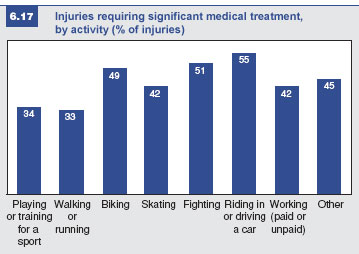Common menu bar links
Institutional links
Diseases & Conditions
Health & Safety
Research & Statistics
Agency Information
Search Box
Healthy settings for young people in Canada
Previous | Table of Contents | Next
How are Young People Injured?
Injuries to young people are caused by many different activities. Figures 6.8 to 6.10 show the range of activities associated with occurrence of injuries for students in Grades 6, 8, and 10 respectively. It is clear that sports are a major cause of injury across grade and gender.
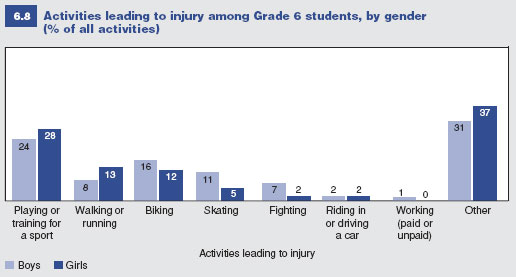
Although the percentage of injuries caused by physical fights is small compared with sports (Figures 6.8 to 6.10), violence can clearly have a lasting impact on various aspects of health that goes beyond the violent encounter and associated physical injury. Injuries caused by work-related activities are also uncommon, although they increase in the older age groups as young people enter the formal workforce.
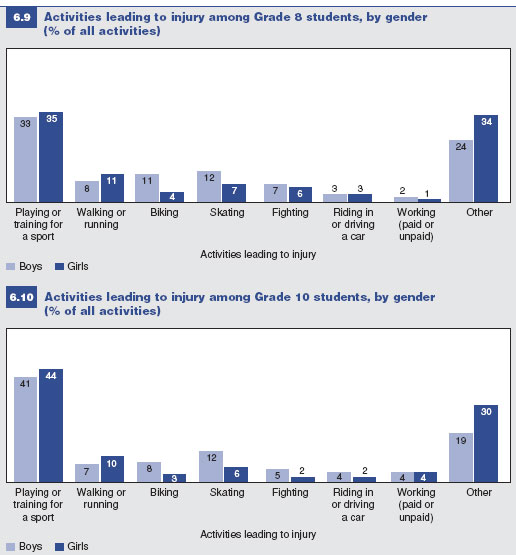
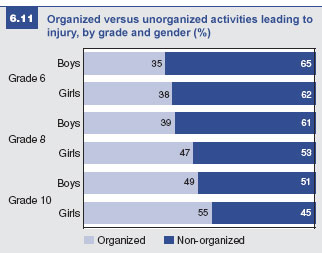 Figure 6.11 shows that the percentage
of injuries that happen
during organized activities tends
to increase with advancing grade.
These high percentages reflect
the general increased level of
organized activities in young people’s
lives as they grow and develop.
Research shows that sports
represent a large portion of the
organized activities during which
young people experience injuries.
Figure 6.11 shows that the percentage
of injuries that happen
during organized activities tends
to increase with advancing grade.
These high percentages reflect
the general increased level of
organized activities in young people’s
lives as they grow and develop.
Research shows that sports
represent a large portion of the
organized activities during which
young people experience injuries.
Where are young people injured?
Table 6.12 shows that the vast majority of injuries to young people happen at sports facilities (16 to 43%), at home or in yards (17 to 35%), or in school at recess or lunch (10 to 19%). Injuries that occur at sports facilities or fields increase notably in older grades, while injuries that happen at home or during school hours decline with age.
| Grade 6 | Grade 7 | Grade 8 | Grade 9 | Grade 10 | ||||||
| Boys | Girls | Boys | Girls | Boys | Girls | Boys | Girls | Boys | Girls | |
| Home or yard | 27 | 35 | 19 | 32 | 19 | 24 | 17 | 21 | 17 | 21 |
| Sports facility or field | 24 | 16 | 27 | 18 | 33 | 30 | 42 | 35 | 43 | 37 |
| School at recess or lunch | 18 | 19 | 17 | 19 | 16 | 16 | 10 | 16 | 13 | 13 |
| School after hours | 4 | 2 | 4 | 6 | 4 | 6 | 5 | 6 | 4 | 6 |
| Street or parking lot | 10 | 8 | 11 | 9 | 12 | 8 | 10 | 6 | 10 | 5 |
| Other | 17 | 20 | 23 | 18 | 16 | 16 | 17 | 16 | 14 | 18 |
Where are young people’s injuries treated?
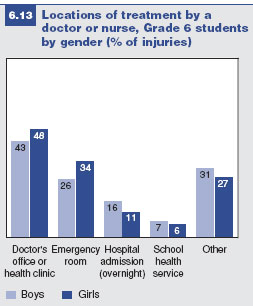 Young people seek medical care from a
variety of sources following the occurrence
of an injury. The most common sources,
shown by grade in Figures 6.13 to 6.15,
are a doctor’s office or health clinic, followed
by an emergency room. The proportion
of injuries receiving treatment in
emergency rooms increases in the older
grades, while the proportion requiring
overnight hospital admission decreases.
Visits to school health services for treatment
of injuries are rare at all grade levels,
probably reflecting the lack of school nurses
in many Canadian schools. In general,
the patterns of treatment observed by gender
are quite consistent across the grades.
Young people seek medical care from a
variety of sources following the occurrence
of an injury. The most common sources,
shown by grade in Figures 6.13 to 6.15,
are a doctor’s office or health clinic, followed
by an emergency room. The proportion
of injuries receiving treatment in
emergency rooms increases in the older
grades, while the proportion requiring
overnight hospital admission decreases.
Visits to school health services for treatment
of injuries are rare at all grade levels,
probably reflecting the lack of school nurses
in many Canadian schools. In general,
the patterns of treatment observed by gender
are quite consistent across the grades.
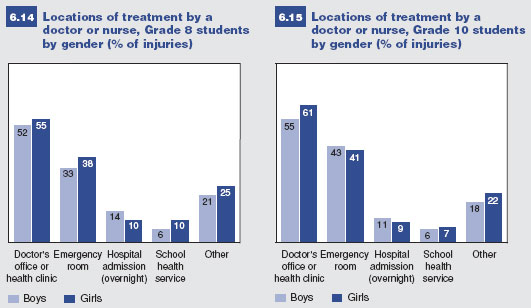
The proportion of students with injuries requiring an overnight hospital stay are charted for three survey years in Figure 6.16. In general, there is no clear trend over time for these more serious injuries.
Figure 6.17 shows that the types of injury-causing activities most likely to lead to significant medical treatment include motor vehicle events, fighting, and biking. Significant medical treatment is defined on the HBSC survey as casting, stitches, surgery, or hospital admission. It is surprising that, although sports are a more frequent cause of injury among young people (see Figures 6.8 to 6.10), sports injuries are less likely to require significant medical treatment.
Data on peer violence and weapon carrying are presented in Chapter 5 on Bullying and Fighting.

